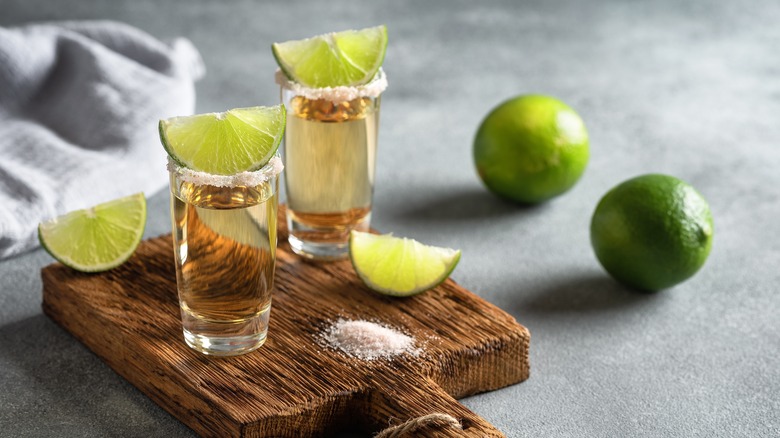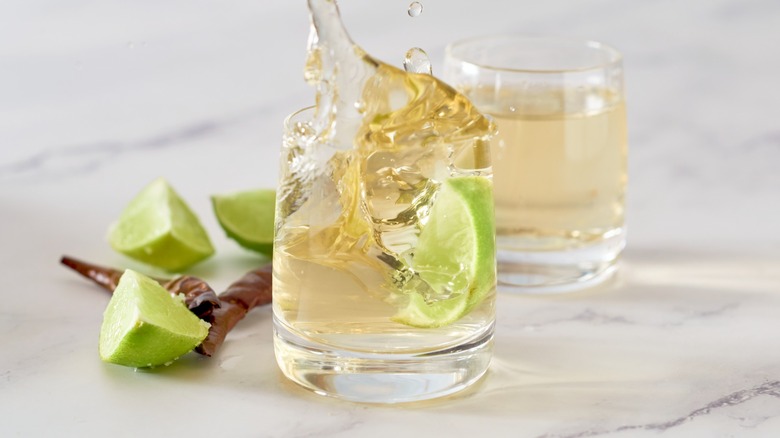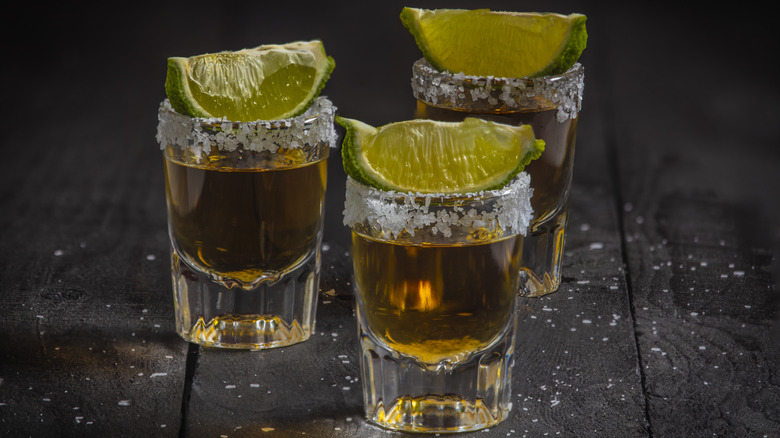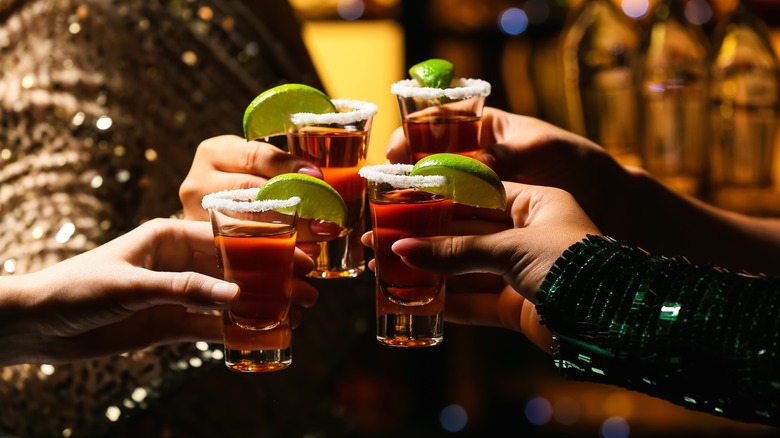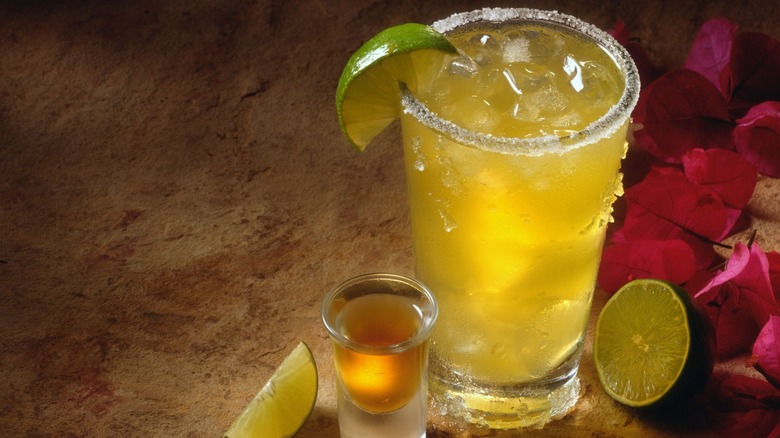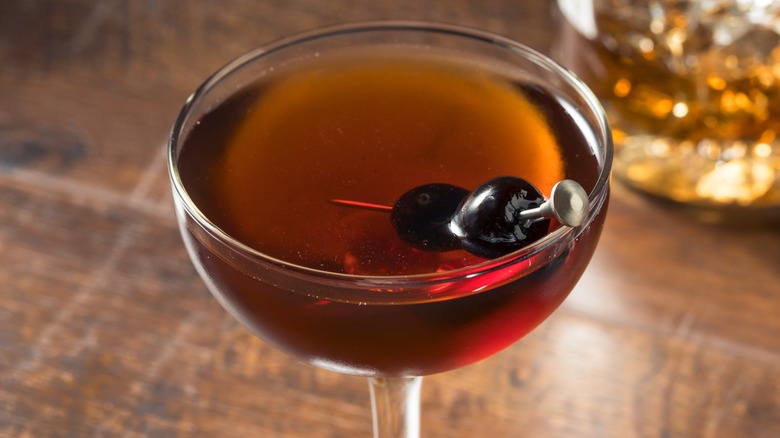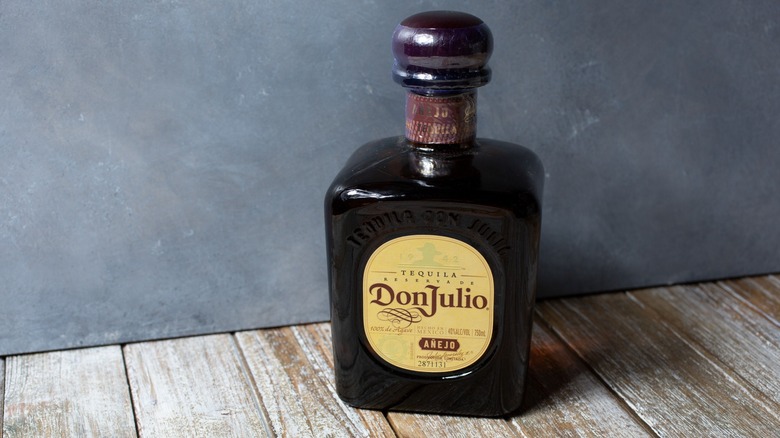What's The Difference Between Reposado And Añejo Tequila?
Newcomers to the world of tequila may only know it as the clear booze with a bite served in a shot glass with a lime wedge or blended into a frozen Margarita. But blanco tequila is quite literally just the beginning. All tequilas begin as blancos, but through a particular aging process, two distinct tequila varieties are born: reposado and añejo. Reposado and añejo tequilas both spend months or years aging in oak barrels, during which time they develop a rich golden color and complex flavor profile not seen in younger blanco tequilas.
Reposado, which ages for two months to a year, has a subtly spicy tequila flavor that lends itself equally well to cocktails and straight-up sipping. Añejo tequila, meanwhile, has a more complex flavor profile thanks to its longer aging time of one to three years, making it better suited to be enjoyed on its own with little help from other ingredients. Here's everything you need to know about the difference between reposado and añejo tequila.
What is reposado tequila?
Reposado means "rested" in Spanish, and the name aptly describes the process by which this type of tequila is born. After distilling, blanco tequila is transferred to an oak barrel where it rests anywhere from two months to a year. During this time, the tequila takes on a golden color and oaky flavor from the barrel, distinguishing it from its younger blanco siblings. Reposado tequila is smoother than blanco tequila, with notes of vanilla, citrus, pepper, and smoke enhancing its natural agave flavor.
Some reposado tequilas spend their aging months in repurposed barrels that once held other spirits such as whiskey, bourbon, or Cognac, adding even more layers to the flavor profile. This makes reposado tequila especially versatile at the bar. The spirit's subtle complexity stands up to straight sipping, whether neat or on the rocks, but it can also bring an unexpected twist to tequila cocktails like Margaritas and Palomas.
What is añejo tequila?
Añejo tequila also begins its journey as a blanco, which is distilled from blue agave piñas — or hearts — into a crystal clear spirit. From there, it spends one to three years aging in oak casks, following the same path as the younger reposado tequila. But after the reposado is poured from its barrel and bottled at a year or less, the añejo, which means "old" in Spanish, keeps waiting for up to three times as long. This lengthy aging process further concentrates the complex flavors from the oak barrels.
Añejo tequilas often have a rich, caramel flavor that borders on sweet, plus hints of whatever spirit once occupied their aging barrels. Some añejo aficionados would argue that the best way to enjoy this tequila is to sip it neat, like a fine whiskey. But it holds up in spirit-forward cocktails, too, sometimes even serving as a stand-in for other liquors in drinks such as Manhattans and Old Fashioneds.
Añejo tequila is sweeter
Reposado and añejo tequilas both earn their unique flavors by spending months or even years in oak barrels. This interplay with the wood is so key to the aging process that the barrel size is limited by the Norma Oficial Mexicana (NOM) — the official regulating body of tequila production — to ensure that a sufficient volume of the spirit is always in contact with the barrel itself. Some distillers use barrels that once aged other liquors, such as bourbon, whiskey, or Cognac, further increasing the complexity and variety of flavors in each bottle.
Reposado has up to one year to absorb and develop its unique personality from its barrel, while añejo can rest for up to three years before bottling, and this extra time makes all the difference. In the first year, reposado tequila becomes slightly spicy, with subtle hints of vanilla, citrus, and smoke, depending on the barrel. In the years after that, these flavors lose their subtlety, developing an intensity on par with other spirits like bourbon, with louder notes of caramel, vanilla, and cinnamon. Añejos that approach the three year mark often develop a satisfying sweetness, in part due to evaporation of the spirit over time, known as "the angels' share," which further concentrates its flavors.
Reposado tequila is more versatile
If you've only got room for one tequila on your bar, a reposado is your best bet. This tequila's complex flavor profile makes it a smooth sipping spirit, having lost the edge of younger blanco tequilas through its aging process. The mellow, oaky notes of reposado tequila shine whether neat or on the rocks, and it's less abrasive than a blanco when served with salt and lime in a shot.
But a reposado is also an excellent tequila for almost any cocktail. It provides a simple upgrade to traditional tequila cocktails such as Margaritas and Palomas, but it can also add an unexpected twist when substituted for other liquors, like the vodka in a Moscow Mule. Añejos, on the other hand, can be too much for most cocktails.
The extra aging time of the añejo tequila brings stronger flavors to the party, which can overwhelm many mixed drinks or get lost in them altogether. Some tequila purists would even argue that putting a good añejo into a cocktail is like pouring your best vintage wine into a Sangria. But a reposado is the perfect middle ground, ready to star in whatever situation comes your way without ever feeling like its potential is being wasted.
Añejo tequila is better for straight sipping
Añejo tequilas are perfect for the type of people who take their whiskey neat. The lengthy aging process that creates this spirit allows it to develop complex flavors that are on par with dark spirits such as brandy, Scotch, and bourbon. It's the perfect sample sip to lure fans of these liquors over to the world of tequila. Añejo tequila is no one-trick pony, though.
While it might seem like a waste to bury all that aged goodness under a bunch of mixers in a cocktail, there are certain drinks you can mix with tequila to enhance the añejo's bolder profile. An Old Fashioned, for example, brings out the smokier notes of añejo tequila with bitters, orange zest, and a dash of agave syrup without losing them under a bunch of soda or juice. Likewise, the vermouth and brandied cherry of a Manhattan shines a lovely spotlight on the añejo's sweeter caramel flavors.
Reposado tequila is more affordable
Añejo tequilas are often more expensive than reposado tequilas. Añejo tequila gets its bold and complex flavor profile from the lengthy amount of time it spends aging in oak barrels, and for the distillers, that time is money. Not only do añejos have to rest longer before they start making money for their distillery, but they also lose more volume over time as the volatile alcohols evaporate. All of this adds up to a higher price tag.
While reposados usually retail for $100 or less — and are often in the $30 to $60 range – añejos are usually around $50 to $150 per bottle, and extra añejos — which are barrel-aged for three years or longer — can be quite pricey, often costing $500 or more. This is one of the reasons that reposados are better suited to tequila cocktails. The high price of añejos, meanwhile, encourages sippers to slow down and savor the spirit's flavors rather than losing them in a mixed beverage.
